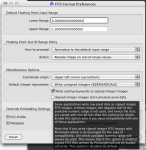roryt
Well-known member
Hello,
Not sure if this is a PI bug, but I have no other clue so far.
I have a stack of bias that PI shows with unreasonable histogram/statistics and the calibration from PI fails.
From the other hand both nebulosity (the creator) and MaximDL can read and show them correctly.
The same with the master bias, created with nebulosity. Please see the attached screenshots.
The FIT used can be downloaded from http://www.roryt.gr/astronomy/bias.zip .
Of course no stretch has been applied.
Any help will be much appreciated, currently I'm stacked to use Neb to do the pre-processing and I hate to do so.
Since 1.6 I use PI for everything and I'm happy with it.
Not sure if this is a PI bug, but I have no other clue so far.
I have a stack of bias that PI shows with unreasonable histogram/statistics and the calibration from PI fails.
From the other hand both nebulosity (the creator) and MaximDL can read and show them correctly.
The same with the master bias, created with nebulosity. Please see the attached screenshots.
The FIT used can be downloaded from http://www.roryt.gr/astronomy/bias.zip .
Of course no stretch has been applied.
Any help will be much appreciated, currently I'm stacked to use Neb to do the pre-processing and I hate to do so.
Since 1.6 I use PI for everything and I'm happy with it.




